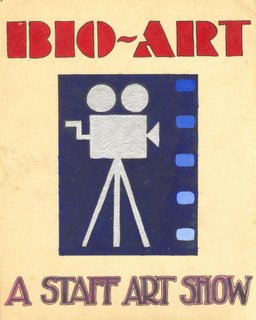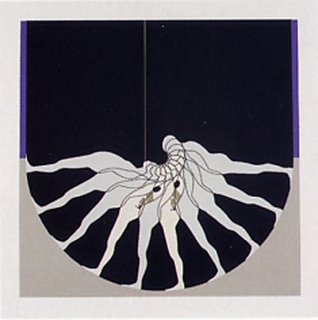Photographer Jack Leigh (1948-2004) was part of the
Biograph Theatre’s staff in late-1973/early-1974. While he worked at the
Biograph as an usher, Leigh taught me to play Half-Rubber, a game he
said originated in his home town, Savannah. Half-Rubber is a three-man
baseball-like game that is played with a broom handle and half of a red
rubber ball.
Jack’s best known picture was snapped in 1993, when he was commissioned to shoot the photograph in a Savannah cemetery that would appear on the cover of what became a bestselling book -- “Midnight in the Garden of Good and Evil” by John Berendt. Later the same photo was used to promote the movie with the same title.
 When
I knew him, Jack was earnest and quick-witted. He liked to play chess
and talk about movies, and of course -- photography. In his Biograph
days he was already a very good photographer.
When
I knew him, Jack was earnest and quick-witted. He liked to play chess
and talk about movies, and of course -- photography. In his Biograph
days he was already a very good photographer.
Once, when we went out shooting pictures together, he snapped his shutter maybe twice. In the same amount of time, a couple of hours, I went through two rolls of Tri-X. The quiet style Jack would use throughout his career was already evident. He eventually authored six books of photographs, including "Oystering," which featured a foreword by James Dickey.
So, to kill time one warm afternoon, I cut a ball in half, ruined a broom and crossed the street with Jack and the theater’s assistant manager, Bernie Hall, to play what was a new game to me. At the time there were several vacant lots on Grace Street, across from the Biograph.
It turned out the key to pitching was to throw the half-ball with a side-arm delivery, with the flat part down. That made it curve wildly and soar, somewhat like a Frisbee. Hitting it with a broomstick or even catching the damn thing was quite another matter. Oh, and hitting the ball on a bounce was OK, too. In fact, it was better to do so, from a strategic standpoint.
 The
pitcher threw the half-sphere in the general direction of the batter. If
the batter swung and missed, and he usually did miss, the catcher did
his best to catch it. When the catcher did
catch it on the fly, providing the batter had swung, the batter was out. Then the
pitcher moved to the catching position, and the catcher became the
batter, and so forth. Runs were scored in a similar fashion to other
home run derby-like games.
The
pitcher threw the half-sphere in the general direction of the batter. If
the batter swung and missed, and he usually did miss, the catcher did
his best to catch it. When the catcher did
catch it on the fly, providing the batter had swung, the batter was out. Then the
pitcher moved to the catching position, and the catcher became the
batter, and so forth. Runs were scored in a similar fashion to other
home run derby-like games.
But the best reason to play, other than the laughs stemming from how foolish we looked dealing with the crazy, flat-sided ball, was the kick that came from hitting it. When we connected with that little red devil it left the broomstick bat like a rocket. It felt better than crushing a golf ball. Smashing it across the lot, completely over the theater and halfway to Broad Street was a gas.
Click here to read more about Jack Leigh.
Jack’s best known picture was snapped in 1993, when he was commissioned to shoot the photograph in a Savannah cemetery that would appear on the cover of what became a bestselling book -- “Midnight in the Garden of Good and Evil” by John Berendt. Later the same photo was used to promote the movie with the same title.
 When
I knew him, Jack was earnest and quick-witted. He liked to play chess
and talk about movies, and of course -- photography. In his Biograph
days he was already a very good photographer.
When
I knew him, Jack was earnest and quick-witted. He liked to play chess
and talk about movies, and of course -- photography. In his Biograph
days he was already a very good photographer.Once, when we went out shooting pictures together, he snapped his shutter maybe twice. In the same amount of time, a couple of hours, I went through two rolls of Tri-X. The quiet style Jack would use throughout his career was already evident. He eventually authored six books of photographs, including "Oystering," which featured a foreword by James Dickey.
So, to kill time one warm afternoon, I cut a ball in half, ruined a broom and crossed the street with Jack and the theater’s assistant manager, Bernie Hall, to play what was a new game to me. At the time there were several vacant lots on Grace Street, across from the Biograph.
It turned out the key to pitching was to throw the half-ball with a side-arm delivery, with the flat part down. That made it curve wildly and soar, somewhat like a Frisbee. Hitting it with a broomstick or even catching the damn thing was quite another matter. Oh, and hitting the ball on a bounce was OK, too. In fact, it was better to do so, from a strategic standpoint.
 The
pitcher threw the half-sphere in the general direction of the batter. If
the batter swung and missed, and he usually did miss, the catcher did
his best to catch it. When the catcher did
catch it on the fly, providing the batter had swung, the batter was out. Then the
pitcher moved to the catching position, and the catcher became the
batter, and so forth. Runs were scored in a similar fashion to other
home run derby-like games.
The
pitcher threw the half-sphere in the general direction of the batter. If
the batter swung and missed, and he usually did miss, the catcher did
his best to catch it. When the catcher did
catch it on the fly, providing the batter had swung, the batter was out. Then the
pitcher moved to the catching position, and the catcher became the
batter, and so forth. Runs were scored in a similar fashion to other
home run derby-like games.But the best reason to play, other than the laughs stemming from how foolish we looked dealing with the crazy, flat-sided ball, was the kick that came from hitting it. When we connected with that little red devil it left the broomstick bat like a rocket. It felt better than crushing a golf ball. Smashing it across the lot, completely over the theater and halfway to Broad Street was a gas.
Click here to read more about Jack Leigh.











